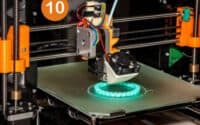Should Every Ship Owner Invest in 3D Printing Technology?
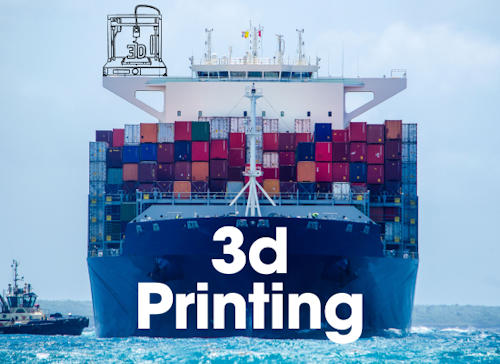
In the highly competitive and operationally demanding maritime industry, the ability to quickly adapt to unexpected challenges and streamline maintenance processes is paramount. Investing in a 3D printer offers ship owners a range of benefits that enhance efficiency, reduce costs, and improve safety. Here’s why incorporating 3D printing technology aboard ships is a smart investment.
* Please send feedback/suggestions to editor @ shipuniverse.com
1. Cost Savings and Efficiency
Reduced Inventory Costs: Traditionally, ships carry a vast inventory of spare parts to ensure readiness for any mechanical failure. This approach ties up capital and storage space. With a 3D printer on board, ships can produce parts on-demand, significantly reducing the need for extensive inventories and the associated costs.
Minimized Downtime: Mechanical failures can lead to costly delays as ships wait for replacement parts to arrive. A 3D printer allows for immediate production of the needed parts, minimizing downtime and keeping the ship operational. This capability is particularly valuable in remote areas where supply chains are less reliable.
2. Enhanced Operational Flexibility
Rapid Prototyping and Customization: 3D printing enables the rapid prototyping of custom parts tailored to specific needs, whether it’s for a unique repair situation or an upgrade to existing systems. This flexibility allows ship owners to innovate and adapt without waiting for external suppliers.
On-the-Spot Repairs: The ability to produce replacement parts on the spot means that ships can address issues immediately, whether it’s a broken valve handle, a damaged sensor housing, or any other critical component. This capability enhances the ship’s operational resilience and safety.
3. Improved Safety and Risk Management
Emergency Solutions: As demonstrated in various scenarios, 3D printing can provide quick solutions to emergency situations, such as repairing a cracked impeller or replacing a damaged lifeboat release mechanism. These immediate fixes can prevent further damage and ensure the safety of the crew and vessel.
Enhanced Maintenance: Regular maintenance often involves the replacement of worn-out parts. With a 3D printer, ship crews can produce these parts as needed, ensuring that maintenance schedules are adhered to and that systems remain in optimal condition.
4. Environmental Benefits
Reduced Waste: 3D printing is an additive manufacturing process, meaning it creates objects by adding material layer by layer. This method generates less waste compared to traditional subtractive manufacturing, which cuts away material from a larger block. Reducing waste aligns with environmental sustainability goals.
Lower Carbon Footprint: By producing parts on board, ships can reduce their dependency on long supply chains, which involve significant transportation emissions. This reduction in logistics can contribute to a lower overall carbon footprint for the maritime industry.
5. Future-Proofing the Fleet
Keeping Up with Technological Advances: The maritime industry is continually evolving, with new technologies and innovations emerging regularly. Investing in a 3D printer positions ship owners at the forefront of technological advancements, ensuring their fleet remains competitive and capable of integrating new solutions as they develop.
Attracting Skilled Crew: Modern and technologically advanced equipment, such as 3D printers, can attract skilled crew members who are interested in working with cutting-edge technology. This can improve crew retention and the overall quality of the workforce.
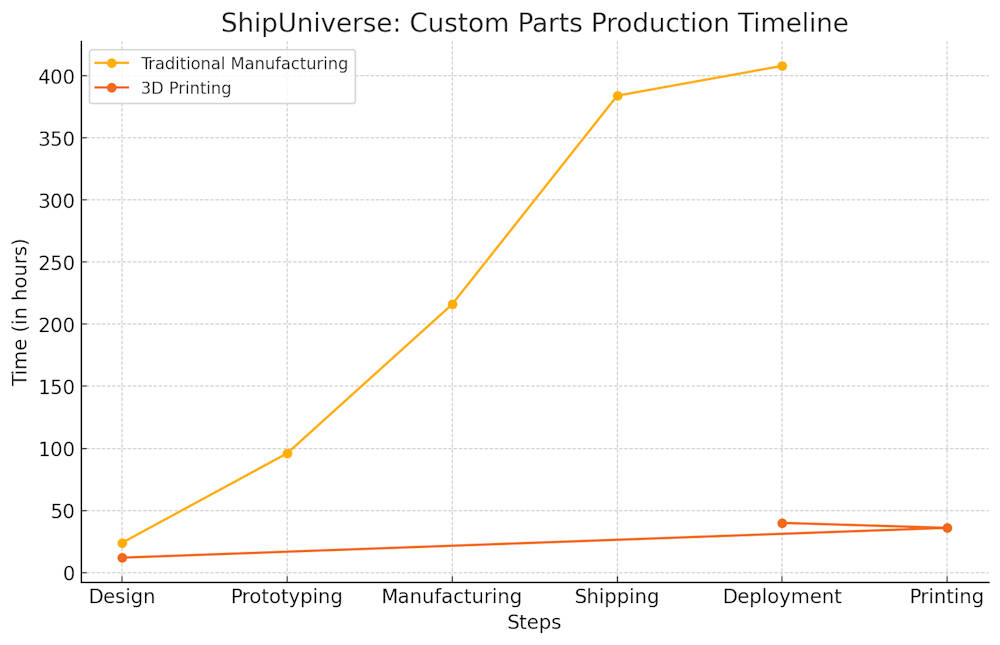
- Traditional Manufacturing involves multiple steps: Design, Prototyping, Manufacturing, Shipping, and Deployment, totaling approximately 408 hours.
- 3D Printing streamlines the process with fewer steps: Design, Printing, and Deployment, totaling approximately 40 hours.
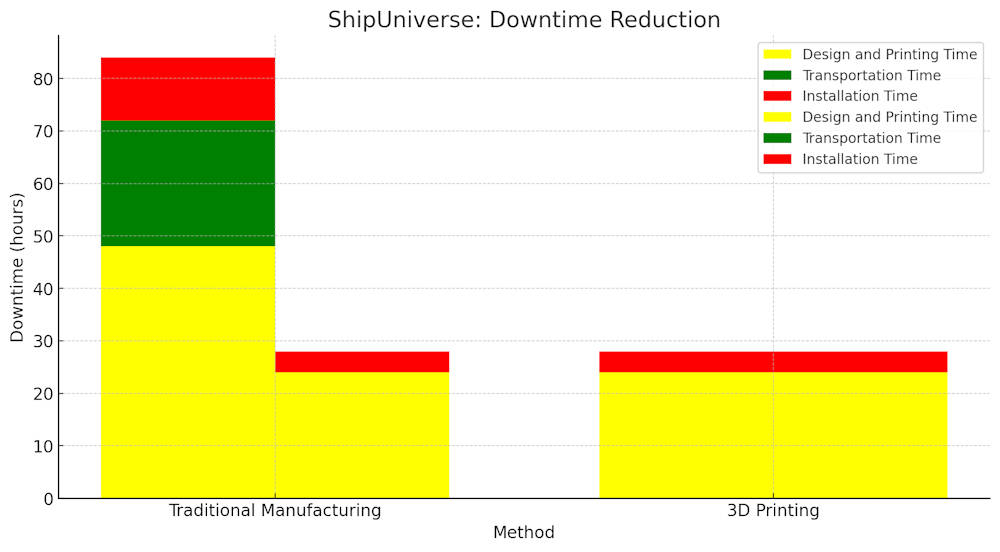
- Traditional Manufacturing includes the following steps:
- Design and Printing Time: 48 hours
- Transportation Time: 24 hours
- Installation Time: 12 hours
- Total Downtime: 84 hours
- 3D Printing includes the following steps:
- Design and Printing Time: 24 hours
- Transportation Time: 0 hours (since the part is printed onboard)
- Installation Time: 4 hours
- Total Downtime: 28 hours
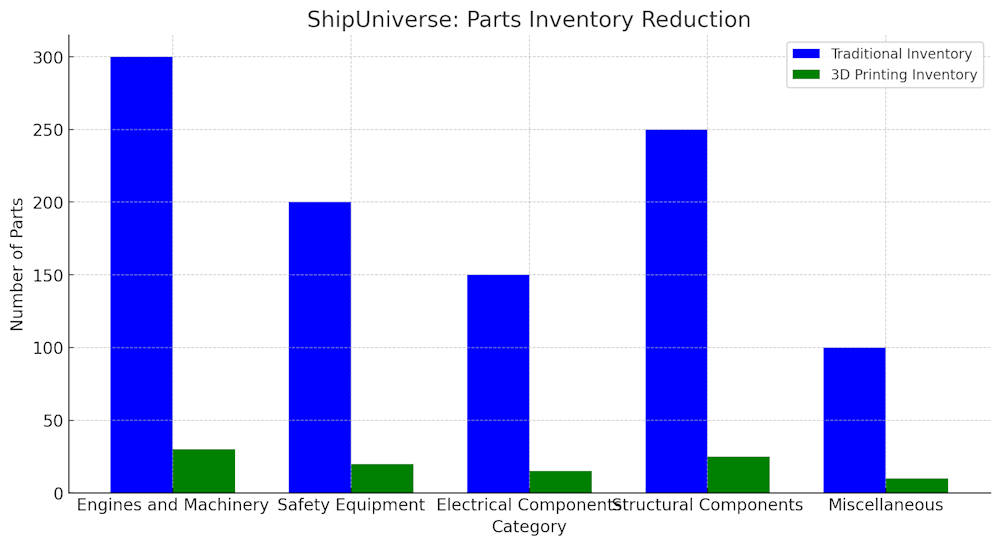
Example Scenarios @ Sea
Scenario 1: Broken Impeller in a Cooling Pump
Situation: While navigating through rough seas, the ship’s main engine cooling pump suddenly stops functioning. Upon inspection, it is discovered that the impeller inside the pump has broken. Without a functioning cooling pump, the engine risks overheating, potentially leading to catastrophic failure.
Solution: Using a 3D printer equipped with suitable materials, the engineering team prints a new impeller based on the digital model stored in the ship’s maintenance system. Within a few hours, the new impeller is ready and installed, restoring the cooling pump’s functionality and ensuring the engine operates safely.
Outcome: The quick production and replacement of the impeller prevent engine damage, avoid costly delays, and ensure the ship continues its voyage with minimal interruption.
Scenario 2: Damaged Valve Handle in the Fuel System
Situation: During routine operations, a critical valve handle in the ship’s fuel system is accidentally broken, making it impossible to regulate fuel flow properly. The ship is far from port, and waiting for a replacement part would result in significant downtime and potential fuel management issues.
Solution: The crew uses the onboard 3D printer to manufacture a new valve handle from a durable polymer. The replacement handle is designed to fit precisely and withstand the operational stresses of the fuel system. After printing and a quick quality check, the new handle is installed, allowing the crew to regain full control over the fuel system.
Outcome: By rapidly producing the replacement handle, the ship avoids operational delays and maintains efficient fuel management, demonstrating the practical benefits of having 3D printing capabilities on board.
Scenario 3: Failed Electrical Insulator in the Navigation System
Situation: The ship’s navigation system experiences intermittent failures, traced back to a cracked electrical insulator that protects sensitive components. Without a proper insulator, there’s a risk of electrical shorts, which could compromise the navigation system’s reliability.
Solution: The crew uses the 3D printer to create a new insulator using high-strength, electrically non-conductive material. The digital blueprint for the insulator is retrieved from the ship’s database, and within a short time, a precise replacement is produced. After ensuring the insulator meets safety standards, it is installed, and the navigation system is tested for proper functionality.
Outcome: The new insulator restores the navigation system’s reliability, ensuring safe and accurate navigation. The rapid resolution of the issue highlights the critical role of 3D printing in maintaining essential systems on commercial ships.
Scenario 4: Cracked Propeller Blade
Situation: While at sea, the crew discovers a crack in one of the propeller blades. Operating with a damaged propeller can lead to further deterioration, reduced propulsion efficiency, and potential safety hazards.
Solution: Using a 3D printer with metal printing capabilities, the crew prints a temporary repair sleeve to reinforce the cracked section of the propeller blade. This sleeve is designed to fit snugly around the blade, providing structural support until a permanent repair can be made in port.
Outcome: The temporary repair allows the ship to continue its voyage safely and maintain propulsion efficiency, avoiding the need for an immediate and costly emergency docking.
Scenario 5: Faulty Sensor Housing in the Engine Room
Situation: A sensor housing in the engine room is found to be cracked, exposing the sensor to potential damage from environmental factors like moisture and heat. This sensor is critical for monitoring engine performance and ensuring safe operation.
Solution: The crew uses the onboard 3D printer to fabricate a new sensor housing from heat-resistant and durable material. The digital design for the housing is either created or retrieved from the ship’s digital library, and the new part is printed and installed, protecting the sensor from harm.
Outcome: The new housing ensures the sensor operates reliably, allowing continuous monitoring of engine performance and contributing to the overall safety and efficiency of the ship’s operations.
Scenario 6: Broken Support Bracket for Communication Equipment
Situation: A support bracket for the ship’s communication equipment breaks during heavy weather, causing the equipment to become unstable and at risk of damage. Effective communication is essential for safety and coordination, especially in adverse conditions.
Solution: The crew quickly designs and prints a new support bracket using high-strength composite material. The replacement bracket is customized to fit the specific equipment and mounting points, ensuring a secure and stable installation.
Outcome: The prompt replacement of the support bracket stabilizes the communication equipment, maintaining the ship’s ability to communicate effectively with other vessels and shore facilities, thereby enhancing operational safety.
Scenario 7: Damaged Lifeboat Release Mechanism
Situation: During a routine safety drill, the crew discovers that the release mechanism of one of the lifeboats is damaged. This critical component is necessary for the quick and safe deployment of the lifeboat in an emergency.
Solution: The crew uses the onboard 3D printer to manufacture a new release mechanism component from high-strength, corrosion-resistant material. The design specifications for the release mechanism are either downloaded from the ship’s database or created by the engineering team.
Outcome: The new release mechanism is installed and tested, ensuring that the lifeboat can be deployed safely and efficiently in an emergency. This quick fix enhances the overall safety preparedness of the vessel.
Scenario 8: Broken Seawater Intake Grate
Situation: While conducting routine inspections, the crew finds that the seawater intake grate is broken. This grate is essential for preventing debris from entering the seawater cooling system, which could lead to blockages and overheating.
Solution: Using the 3D printer, the crew prints a new seawater intake grate from a suitable composite material that is both strong and resistant to corrosion. The design for the grate is either retrieved from the ship’s digital library or created based on the specifications of the original part.
Outcome: The new intake grate is installed, preventing debris from entering the cooling system and ensuring the system operates efficiently. This proactive measure helps maintain the ship’s cooling system, reducing the risk of overheating and potential engine damage.
Scenario 9: Malfunctioning HVAC System Component
Situation: The ship’s HVAC (heating, ventilation, and air conditioning) system experiences a failure due to a broken fan blade in one of the air handling units. This malfunction leads to inadequate ventilation and cooling, affecting the comfort and safety of the crew, especially in hot climates.
Solution: The crew uses the onboard 3D printer to create a new fan blade from a durable, heat-resistant polymer. The design for the fan blade is based on the specifications of the broken component, ensuring a perfect fit and proper balance.
Outcome: The newly printed fan blade is installed, restoring the HVAC system’s functionality. This quick repair ensures that the crew remains comfortable and that the ship’s environmental systems operate efficiently.
Scenario 10: Failed Pipe Connector in the Water Supply System
Situation: A critical pipe connector in the ship’s potable water supply system fails, causing a leak and jeopardizing the water supply for the crew. The ship is far from port, and waiting for a replacement part would lead to water shortages and potential health risks.
Solution: The crew uses the 3D printer to fabricate a new pipe connector using a food-safe, durable material. The design for the connector is either retrieved from the ship’s digital library or created based on the dimensions and specifications of the original part.
Outcome: The new pipe connector is installed, effectively sealing the leak and restoring the water supply system. This rapid response ensures that the crew has continuous access to safe drinking water, maintaining health and hygiene standards on board.
These final scenarios further underscore the versatility and importance of 3D printing technology in addressing emergency situations on commercial ships. By enabling the rapid production of essential components, 3D printing helps ships maintain critical systems, enhance operational efficiency, and ensure the safety and well-being of the crew. As 3D printing technology continues to advance, its role in maritime operations will become even more integral, offering innovative solutions to a wide range of challenges at sea.

Do you have a Maritime Product or Service that may be of interest to Shipowners? Tell us about it here!
Do you have feedback or insights? Please reach out to editor @ shipuniverse.com

